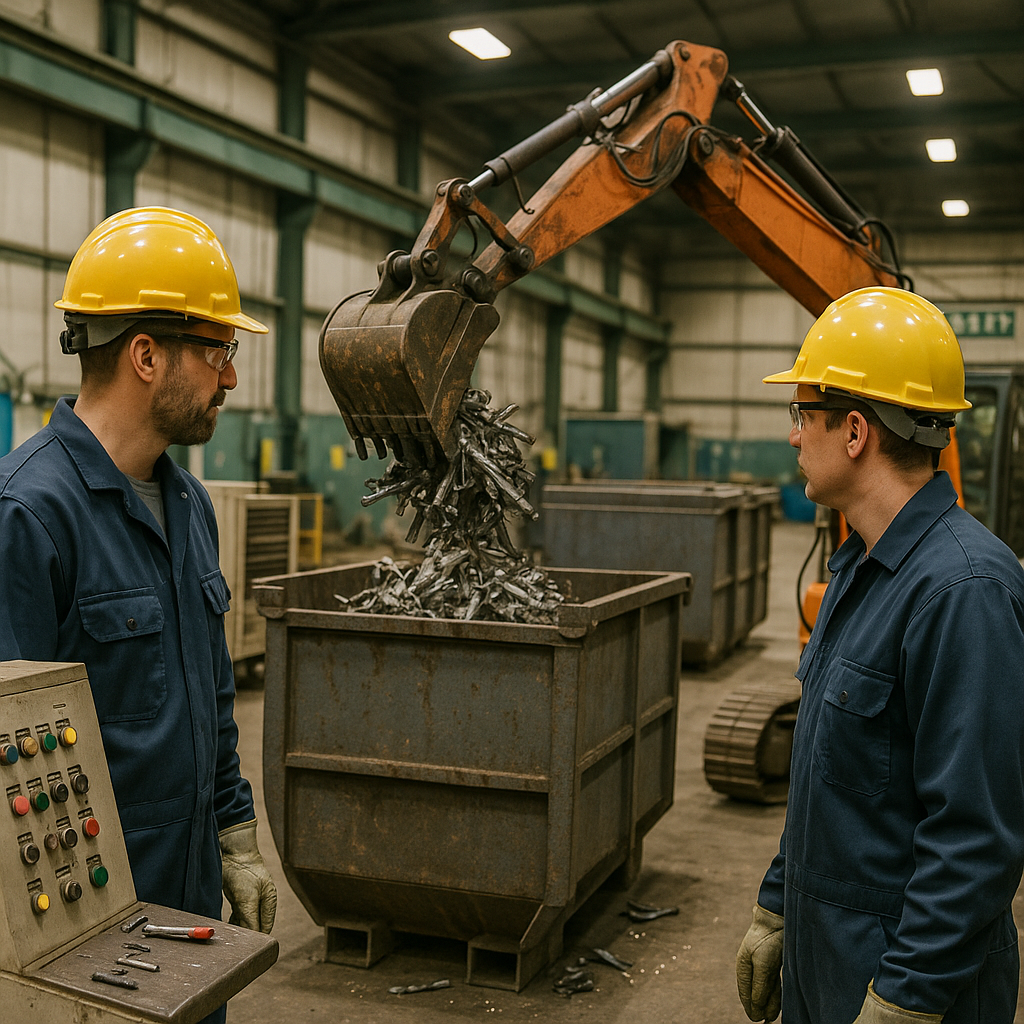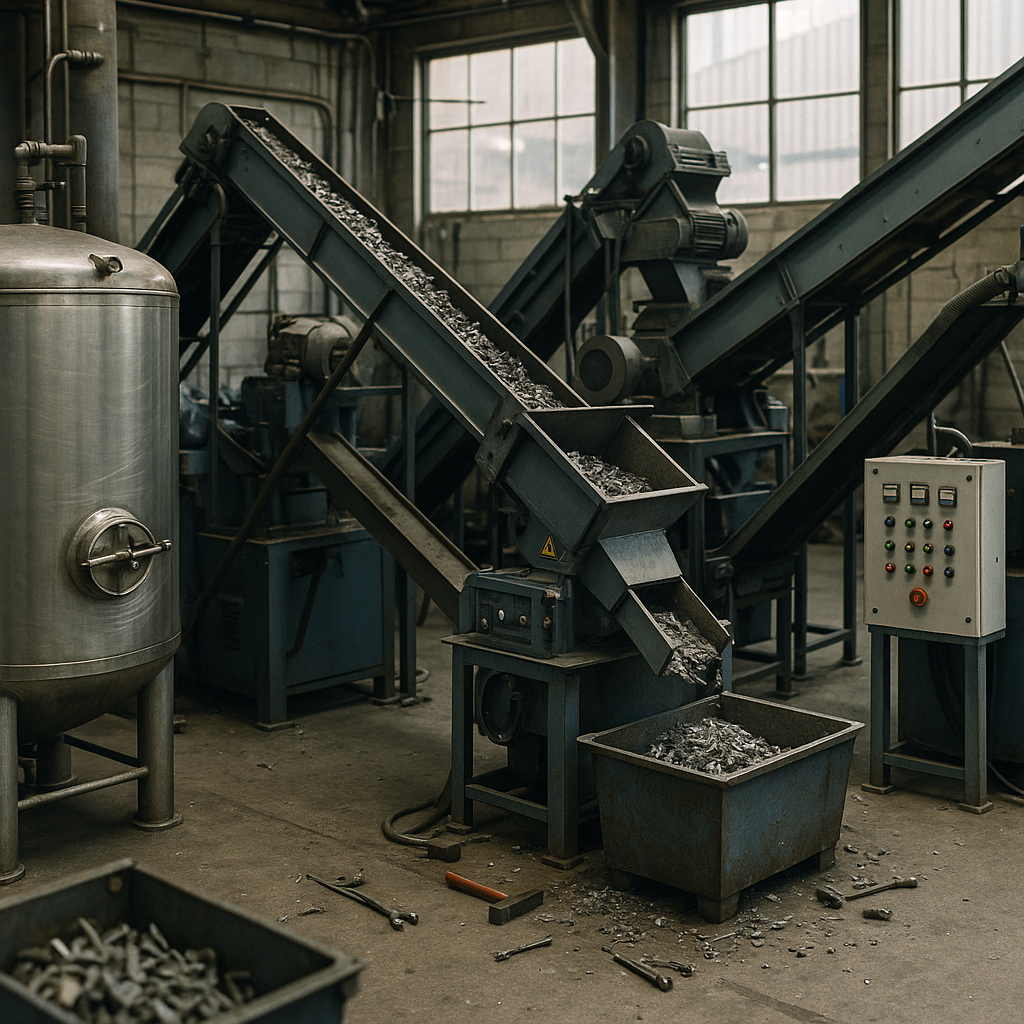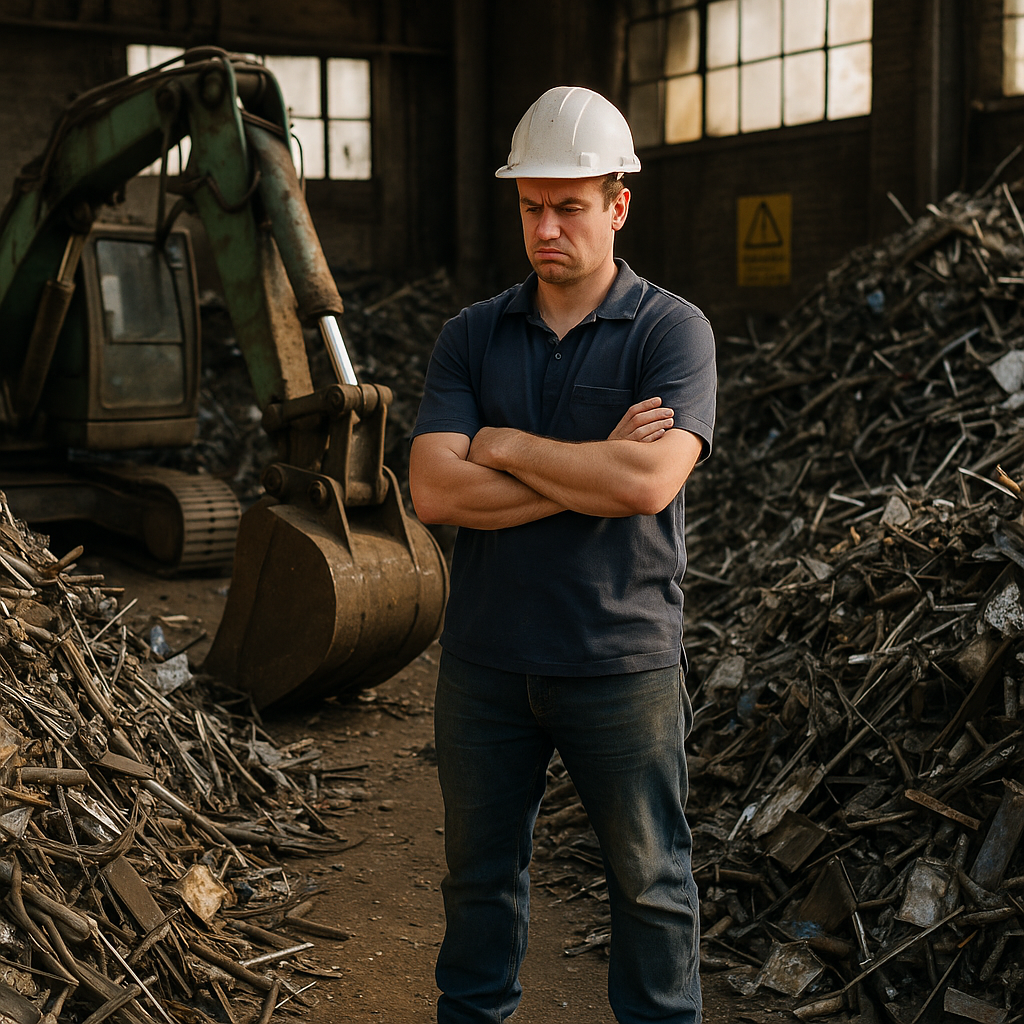5901 Botham Jean Blvd, Dallas, TX 75215
Beyond the Continuous Flow: The Quality & Flexibility Case for Batch Processing
November 1, 2025Each day at recycling yards worldwide, mountains of discarded metal are transformed into valuable resources through a methodical process. Batch processing is key to this transformation. This method involves collecting substantial volumes of scrap metal and processing them in discrete groups or batches, rather than in a continuous flow. From old refrigerators to industrial scraps, these metals await their turn to move through each recycling stage together.
The metal recycling industry faces growing pressure to manage increasing waste volumes while maintaining quality standards. Batch processing offers a practical solution by allowing recyclers to control processing parameters for each specific metal group. This method is particularly effective for operations dealing with varied metal types that require different handling methods. Rare metals like titanium benefit significantly from batch processing because each batch must complete its cycle before the next begins.
How Does the Batch Processing System Work?

Batch processing systems are essential to efficient metal recycling operations. These systems convert bulky scrap metal into manageable, recyclable materials through a series of mechanical stages. Each component plays a crucial role in breaking down metals for eventual reuse in manufacturing.
Feeding System
The batch processing cycle begins with the feeding system. Scrap metal is loaded into large hoppers or onto conveyor belts designed to handle significant weight and volume. These systems regulate the material flow, preventing equipment jams while maintaining consistent processing rates.
Modern feeding systems often incorporate vibrating mechanisms that distribute materials evenly. This initial stage is critical as it sets the pace for the entire processing operation. Proper material flow ensures maximum efficiency in subsequent stages.
Grabbing Mechanism
Once material enters the system, hydraulic grabbing mechanisms engage the scrap. These powerful claws or grapples pull metal toward the cutting area with precisely controlled movements. The grabbers must be robust enough to handle various metal types and configurations.
Grabbing mechanisms typically operate through hydraulic pressure systems. The fluid flows through motors throughout the machine to generate sufficient force to manipulate heavy metal pieces. These systems allow precise movement of materials without human intervention.
Cutting Process
The heart of batch processing occurs at the cutting stage. Heavy-duty rotating blades encounter the grabbed material and break it into smaller fragments. These industrial-strength blades exert a tremendous force, easily cutting through thick metals.
Different metals require specific blade configurations, and the cutting machinery must be capable of adjusting to various material types. Some systems employ hammer mills that deliver repeated impacts to break apart particularly tough materials. The cutting process significantly increases the surface-to-volume ratio of the metal, which improves efficiency in later melting stages.
Size Reduction and Screening
After initial cutting, the metal fragments move through a size reduction system. This stage further breaks down the material into consistently sized pieces. Shredders with multiple rotating blades pulverize the metal into smaller particles.
The final processing step involves passing materials through sizing screens. These screens sort fragments by size, allowing properly reduced pieces to continue while redirecting oversized materials back through the system. This quality control measure ensures that only appropriately sized metals advance to subsequent recycling stages.
Size reduction is crucial for downstream processes. Properly sized metal fragments require less energy to melt and result in higher-quality recycled materials. The entire batch processing system works together to transform what was once considered waste into valuable manufacturing resources.
| Aspect | Batch Mixers | Continuous Mixers |
|---|---|---|
| Flexibility and Control | Greater control over recipes and customization. Ideal for smaller batches and frequent formula changes. | High-speed, high-volume production. Less flexibility for specialized recipes or small batches. |
| Cleaning and Maintenance | Easier to clean and maintain between cycles; suitable for allergen-sensitive products. | Requires more elaborate cleaning protocols, especially when switching between different product types. |
| Cost Implications | Lower initial costs but potentially higher operational costs due to labor and downtime. | Higher upfront costs but more efficient in the long run, lowering the cost per unit of production. |
| Production Volume | Ideal for smaller-scale or specialty production, accommodating frequent changes. | Best for high-volume manufacturing, supporting large, consistent production runs. |
| Product Type and Consistency | Suited for products needing strict recipe control and frequent customization. | Great for standardized products requiring uniformity across batches. |
| Operational Flexibility | Adaptable to changes in recipes or production requirements, allowing quick switches between products. | Optimized for minimal changes in product types, supporting continuous, uninterrupted production. |
| Budget and Capital Investment | Lower initial costs, consider long-term operational expenses. | Higher upfront investment, more efficient long-term reducing per-unit production costs. |
What Are the Key Components of Batch Processing Equipment?

Batch processing equipment forms the backbone of efficient metal recycling operations. At its core is a robust housing structure designed to withstand the demands of processing various metals. This housing contains and protects all internal components while providing stability during high-stress cutting processes.
The rotor system serves as the primary cutting mechanism, featuring specialized saw teeth cutters arranged for efficient material processing. These teeth are engineered for specific metal types, ensuring optimal cutting performance across materials from aluminum to steel.
Hardened blades complement the rotor system by providing precise cutting capabilities. These blades are crafted from specialized alloys that resist wear even when processing abrasive metals, enhancing efficiency by reducing downtime for maintenance and replacement.
Powering the system is a low-speed, high-torque motor. This type of motor is essential as it delivers consistent power even when cutting through dense metals. Its low-speed design prevents overheating during extended operations, while the high torque allows the equipment to manage sudden resistance without stalling.
Advanced control systems represent the intelligence behind batch processing equipment. They monitor parameters like temperature, load, and processing speed. When excessive resistance or potential jams occur, these controls can automatically reverse the rotor direction to clear obstructions and prevent damage.
Feeding mechanisms ensure consistent material flow into the cutting zone, controlling the rate at which metal enters the area to prevent overloading while maintaining optimal throughput rates. Well-designed feeding systems reduce jamming risks and ensure uniform processing.
Safety features are integrated throughout quality batch processing equipment, with emergency stop systems, overload protection, and thermal monitoring providing protection for operators and the equipment. These features automatically halt operations when unsafe conditions are detected, preventing accidents and equipment damage.
Dust collection and noise suppression components address environmental concerns. Modern batch processors include systems to capture metal particles and reduce operational noise, creating safer working conditions while adhering to environmental regulations.
What Are the Benefits of Batch Processing in Metal Recycling?

Batch processing significantly enhances efficiency in metal recycling operations. By managing materials in controlled groups rather than continuous flows, facilities can process large volumes of scrap metal while maintaining strict quality standards. This method allows operators to adjust parameters between batches, optimizing processes for varying material compositions.
The versatility of batch processing is particularly valuable for facilities that handle diverse metal types. Unlike continuous systems designed for specific materials, batch processing equipment can be reconfigured between runs to accommodate everything from aluminum and copper to specialized alloys. This flexibility eliminates the need for multiple dedicated processing lines.
Quality control is one of the most compelling benefits of batch processing in metal recycling. Each batch can be individually tested, sampled, and verified before moving to the next stage. If a batch contains impurities, it can be reprocessed without affecting other materials. This meticulous approach results in cleaner, more consistent recycled metal that meets manufacturer specifications.
Chemical analysis is crucial in ensuring quality during batch processing. Recyclers can determine the exact composition of each batch, ensuring proper classification and sorting. When a batch already has the correct proportion of alloying elements, processors may not need to add more during melting and refining, thus saving costs while maintaining product quality.
Batch processing systems integrate seamlessly with other recycling technologies. Magnetic separators can remove ferrous materials, while eddy current systems can sort non-ferrous metals based on their conductivity. Combined with batch processing, these technologies significantly improve metal recovery rates by ensuring thorough separation at each stage.
The economic benefits of batch processing extend throughout recycling operations. Although initial equipment investment may be lower than in continuous systems, the real value lies in operational flexibility. Processors can adjust to market demands quickly, processing high-value materials when prices are favorable without major equipment changeovers.
Energy efficiency is another advantage of batch processing. Equipment only runs when needed, potentially reducing overall power consumption. This approach helps facilities better control operational costs while reducing their environmental footprint.
| Attribute | Batch Processing | Continuous Processing |
|---|---|---|
| Production Method | Discrete batches processed sequentially | Continuous, non-stop production flow |
| Equipment Maintenance | Less complex, easier to maintain but requires frequent checking | More complex, requires proactive maintenance |
| Production Volume | Smaller, suitable for varied materials | Larger, consistent for single product types |
| Flexibility | High, allows product variation and adjustments between batches | Low, designed for specific products without interruption |
| Quality Control | Post-production checks for each batch | Real-time monitoring with immediate corrections |
| Initial Setup Costs | Lower | Higher |
| Energy and Operational Costs | Potentially higher due to frequent resets | Lower per unit due to scale |
For businesses processing specialized or high-value metals, batch processing offers significant advantages. The method allows for careful handling of sensitive materials that require specific processing parameters. Recyclers can optimize each batch for maximum value recovery, essential when dealing with precious metals or rare alloys.
What Challenges Are Associated with Batch Processing?

Batch processing offers significant advantages in metal recycling operations, yet several challenges can impact its efficiency and cost-effectiveness. Recycling facilities must address these issues to maximize their investment and maintain consistent processing capacity.
High Initial Equipment Costs
The upfront investment for batch processing equipment presents a substantial financial hurdle for many recycling operations. Industrial shredders, balers, and sorting systems often require capital expenditures ranging from tens of thousands to several million dollars, depending on capacity and sophistication.
Small to medium-sized recycling operations may struggle to secure financing for these systems, delaying the implementation of more efficient processing methods. The return on investment period typically extends over several years, requiring careful financial planning.
To mitigate cost concerns, recycling facilities can explore leasing options, phased implementation approaches, or partnerships with other recycling operations to share equipment costs. Government grants and sustainability incentives may also offset initial investments in certain regions.
Metal Jams and Machinery Downtime
Metal jams are among the most common operational challenges in batch processing systems. When oversized or particularly dense materials enter the machinery, they can cause jams that halt operations entirely. These stoppages not only delay processing but can also damage critical components if not addressed promptly.
Contaminants like concrete, large rocks, or unexpected non-metallic materials frequently cause jams in shredders and conveyors. Each occurrence may require manual intervention, creating safety risks for workers and extending downtime.
Implementing proper pre-sorting procedures and installing metal detection systems can significantly reduce jam frequency. Training operators to identify potential jam-causing materials before they enter the processing stream also helps maintain continuous operations.
Regular Maintenance Requirements
Batch processing equipment demands consistent, thorough maintenance to operate reliably. Components like shredder blades experience significant wear and require regular replacement, while motors, hydraulic systems, and conveyors need frequent inspection and servicing.
The abrasive nature of metal processing accelerates component degradation, particularly for cutting edges, bearings, and seals. Without proper maintenance schedules, equipment efficiency declines rapidly, increasing energy consumption and reducing throughput.
Developing comprehensive preventive maintenance programs with detailed documentation helps extend equipment life and reduce unexpected failures. Keeping critical spare parts in inventory and training maintenance staff specifically for recycling equipment can minimize downtime during necessary repairs.
Performance Monitoring Challenges
Maintaining optimal performance across batch processing systems requires continuous monitoring of multiple parameters. Variables such as feed rate, material composition, moisture content, and equipment temperatures all affect processing efficiency.
Many older batch processing systems lack sophisticated monitoring capabilities, making performance optimization difficult. Without real-time data, operators may struggle to identify inefficiencies or potential problems before they cause significant disruptions.
Modern sensor systems and integrated monitoring solutions provide valuable performance data to help operators maintain peak efficiency. Implementing these technologies, even on older equipment, can dramatically improve visibility into the processing operation and support data-driven decision-making.
Preventing Recycling Bottlenecks
Batch processing systems risk creating bottlenecks when different stages operate at mismatched capacities. For instance, if sorting capacity exceeds shredding capacity, materials accumulate and disrupt workflow. These imbalances reduce overall system throughput and create inefficient use of space and resources.
Seasonal variations in material volume can exacerbate bottlenecks, as some recycling operations face significant fluctuations in input throughout the year. During peak periods, insufficient capacity leads to backlogs and potential storage problems.
Carefully matching capacities across processing stages helps minimize bottlenecks. Implementing buffer storage zones between stages and developing flexible scheduling can also help manage flow variations. For facilities with predictable seasonal patterns, temporary additional shifts or equipment rentals may provide cost-effective solutions during high-volume periods.
| Challenge | Description | Mitigation Strategy |
|---|---|---|
| Latency | Batch processing leads to delays as tasks are executed after batch completion. | Implement hybrid processing models that combine batch and real-time methods to handle critical tasks immediately. |
| Complex Scheduling | Errors in scheduling can induce job overlaps and missed deadlines. | Use advanced scheduling tools and real-time monitoring to ensure proper execution timeliness. |
| Data Quality | Errors during processing can compromise the data’s accuracy. | Incorporate pre-processing validation checks and error-checking algorithms. |
| Scalability | Large data volumes can overwhelm existing systems. | Leverage cloud-based platforms and distributed processing tools for better scalability. |
| Error Handling | Failed batches can affect subsequent processing unless managed efficiently. | Introduce robust error handling, retry mechanisms, and monitoring systems to detect and rectify faults. |
| Adaptability | Legacy systems may struggle with adapting to new data processing technologies. | Integrate modern tools and update systems to accommodate changing data processing needs. |
Conclusion: The Future of Batch Processing in Metal Recycling
Batch processing remains a fundamental component of modern metal recycling operations. Its efficiency and versatility make it excellent for managing large volumes of materials while ensuring quality control. This method allows recyclers to process similar materials together, optimizing resource use and minimizing waste. The ability to adjust processing parameters for each batch ensures maximum recovery rates and product quality, solidifying batch processing as an essential approach in today’s recycling industry.
Looking forward, integrating artificial intelligence and automation technologies promises to transform batch processing in metal recycling. AI-powered sorting systems can identify different metal types with high accuracy, reducing contamination and improving recovery rates. Smart sensors will soon monitor batch quality in real-time, automatically adjusting processing parameters for optimal results. These technological advancements will enhance efficiency, sustainability, and profitability across the metal recycling sector.
For businesses and municipalities with recycling needs, staying updated on these developments is essential. Contact Okon Recycling at 214-717-4083 to learn how our advanced batch processing capabilities can help you achieve your recycling goals while contributing to a more sustainable future.
